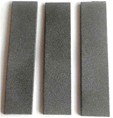Calculation and experimental procedure for determining the modulus of elasticity of porous coatings on a substrate during bending. Part 2. Experimental research
DOI:
https://doi.org/10.20535/2521-1943.2022.6.3.262805Keywords:
modulus of elasticity, coating, microplasma spraying, bending stiffness, porosity, biomedical materialsAbstract
As it was mentioned in the first part of this work, to determine the modulus of elasticity of one of the layers of a double-layer beam during bending, it is necessary to know the modulus of elasticity of the other layer and the bending stiffness of the entire section. Therefore, the purpose of the presented part of the work is to experimentally establish the specified characteristics of coated samples of rectangular cross-section and substrate without coating during three-point bending. The results of experimental studies of elastic-geometric characteristics during bending of samples with coatings of VT1-00 and KTC-110 alloys, applied to a substrate of VT6 alloy by microplasma sputtering, with different degrees of porosity, are presented. Analytical calculations of the modulus of elasticity of the specified coatings were carried out, the results of which make it possible to establish the general regularities of its change depending on their degree of porosity.
References
- P. A. Vityaz', V. M. Kaptsevich and V. K. Sheleg, Poristyye poroshkovyye materialy i izdeliya iz nikh. Minsk: Vysheyshaya shkola, 1987, 164 p.
- V. S. Loskutov and L. I. Dekhtyar', “Mechanical properties of plasma sprayed coatings of zirconium boride, copper, and composites of them”, Soviet Powder Metallurgy and Metal Ceramics, vol. 24, no. 7, pp. 570–572, 1985. DOI: https://doi.org/10.1007/BF00795194.
- Y. Torres, J. J. Pavón, I. Nieto and J. A. Rodríguez, “Conventional powder metallurgy process and characterization of porous titanium for biomedical applications”, Metallurgical and Materials Transactions B, vol. 42, no. 4, pp. 891-900, 2011. DOI: https://doi.org/10.1007/s11663-011-9521-6.
- S. M. Kats, “Elastic modulus of materials with a cellular-porous structure”, Strength of Materials, vol. 4, no. 3, pp. 291–296, 1972. DOI: https://doi.org/10.1007/BF01528406.
- F. P. Knudsen, “Dependence of Mechanical Strength of Brittle Polycrystalline Specimens on Porosity and Grain Size”, Journal of the American Ceramic Society, vol. 42, no. 8, pp. 376–387, 1959. DOI: https://doi.org/10.1111/j.1151-2916.1959.tb13596.x.
- R. M. Spriggs, “Expression for Effect of Porosity on Elastic Modulus of Polycrystalline Refractory Materials, Particularly Aluminum Oxide”, Journal of the American Ceramic Society, vol. 44, no. 12, pp. 628–629, 1961. DOI: https://doi.org/10.1111/j.1151-2916.1961.tb11671.x.
- K. K. Phani and S. K. Niyogi, “Young's modulus of porous brittle solids”, Journal of Materials Science, vol. 22, no. 1, pp. 257–263, 1987. DOI: https://doi.org/10.1007/BF01160581.
- W. Pabst and E. Gregorová, “New relation for the porosity dependence of the effective tensile modulus of brittle materials”, Journal of Materials Science, vol. 39, no. 10, pp. 3501–3503, 2004. DOI: https://doi.org/10.1023/B:JMSC.0000026961.12735.2a.
- D. P. H. Hasselman and R. M. Fulrath, “Effect of Small Fraction of Spherical Porosity on Elastic Moduli of Glass”, Journal of the American Ceramic Society, vol. 47, no. 1, pp. 52–53, 1964. DOI: https://doi.org/10.1111/j.1151-2916.1964.tb14644.x.
- R. W. Rice, “Effects of inhomogeneous porosity on elastic properties of ceramics”, Journal of the American Ceramic Society, vol. 58, no. 9-10, pp. 458–459, 1975. DOI: https://doi.org/10.1111/j.1151-2916.1975.tb19026.x.
- L. A. Lopata, "Zavisimost' modulya uprugosti poroshkovykh pokrytiy ot ikh poristosti pri elektrokontaktnom pripekanii", Zbirnyk naukovykh pratsʹ Kirovohradsʹkoho natsionalʹnoho tekhnichnoho universytetu. Tekhnika v silʹsʹkohospodarsʹkomu vyrobnytstvi, haluzeve mashynobuduvannya, avtomatyzatsiya, no. 24(2), pp. 91-96, 2011.
- Yu. S. Borisov, A. N. Kyslytsa and S. G. Vojnarovych, “Peculiarities of the process of microplasma wire spraying”, The Paton Welding Journal, no. 4, pp. 21–25, 2006.
- S. Voinarovych, O. Kyslytsia, Ie. Kuzmych-Ianchuk, O. Masiuchok, S. Kaliuzhnyi, D. Teodossiev, et al, “Innovative coatings for implants and parts for osteosynthesis”, Series on Biomechanics, vol. 31, no. 4, pp. 27–33, 2017. Available: http://jsb.imbm.bas.bg/page/en/details.php?article_id=254.
- J. Quinn, R. McFadden, C.-W. Chan and L. Carson, “Titanium for Orthopedic Applications: An Overview of Surface Modification to Improve Biocompatibility and Prevent Bacterial Biofilm Formation”, iScience, vol. 23, no. 11, p. 101745, 2020. DOI: https://doi.org/10.1016/j.isci.2020.101745.

- I. Matuła, G. Dercz and J. Barczyk, “Titanium/Zirconium functionally graded materials with porosity gradients for potential biomedical applications”, Materials Science and Technology, vol. 36, no. 9, pp. 972–977, 2020. DOI: https://doi.org/10.1080/02670836.2019.1593603.
- L. I. Tushinskiy, A. V. Plokhov, V. I. Sindeyev and A. A. Stolbov, Konstruktivnaya prochnost' kompozitsii "osnovnoy metall-pokrytiye". Novosibirsk: Nauka, 1996, 296 p.
- Ya. A. Birger and R. R. Mavlyutov, Soprotivleniye materialov. Moskva: Nauka, 1986, 560 p.
- H. S. Pysarenko, O. L. Kvіtka and E. S. Umansʹkyy, Opіr materіalіv. Kyiv: Vyshcha shkola, 2004, 655 p.
- I.-H. Oh, N. Nomura, N. Masahashi and S. Hanada, “Mechanical properties of porous titanium compacts prepared by powder sintering”, Scripta Materialia, vol. 49, no. 12, pp. 1197–1202, 2003. DOI: https://doi.org/10.1016/j.scriptamat.2003.08.018.

Downloads
Published
How to Cite
Issue
Section
License
Copyright (c) 2022 Маріанна Михайлівна Димань, Андрій Молтасов, Сергій Калюжний

This work is licensed under a Creative Commons Attribution 4.0 International License.
Authors who publish with this journal agree to the following terms:
- Authors retain copyright and grant the journal right of first publication with the work simultaneously licensed under CC BY 4.0 that allows others to share the work with an acknowledgement of the work's authorship and initial publication in this journal.
- Authors are able to enter into separate, additional contractual arrangements for the non-exclusive distribution of the journal's published version of the work (e.g., post it to an institutional repository or publish it in a book), with an acknowledgement of its initial publication in this journal.
- Authors are permitted and encouraged to post their work online (e.g., in institutional repositories or on their website) prior to and during the submission process, as it can lead to productive exchanges, as well as earlier and greater citation of published work










